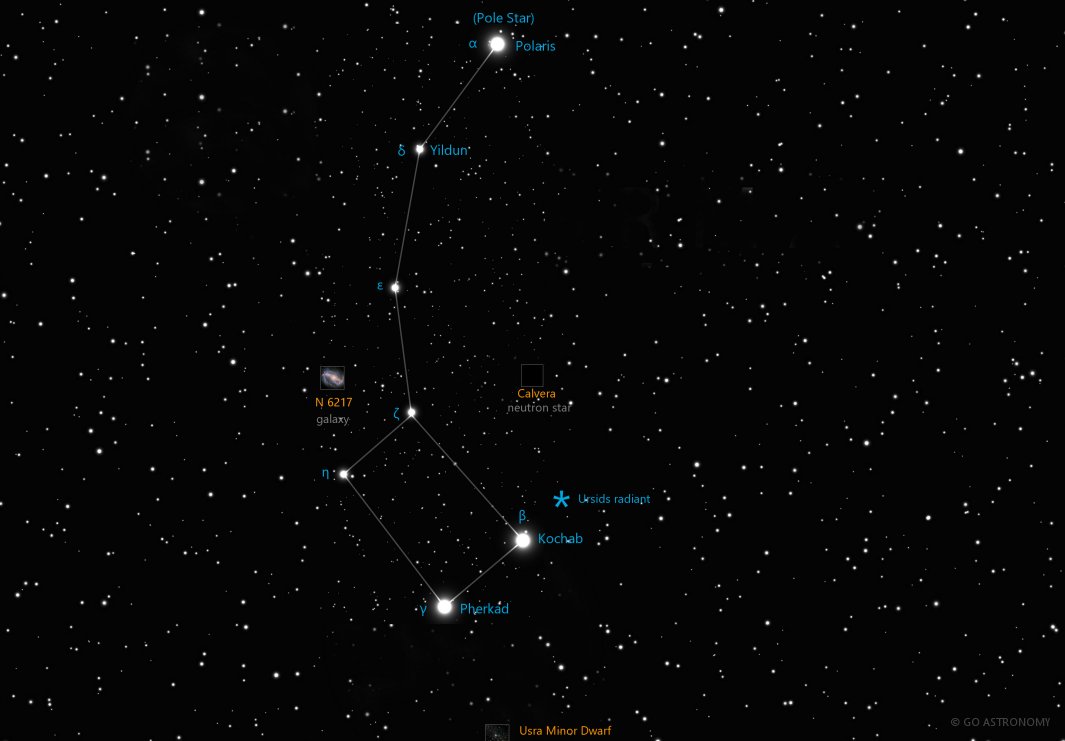Ursa Minor, the Little Bear (UMi)
(ER-suh MY-ner)
The Northern constellation of Ursa Minor, the Little Bear, is best viewed in Summer during the month of June.
Ursa Minor is the 56th largest constellation. It's brightest star is Polaris at magnitude 1.97. The boundary of the Ursa Minor constellation contains 6 stars that host known exoplanets.
Ursa Minor is a circumpolar constellation, so is visible year-round in the Northern hemisphere. Conversely, it is not visible in the opposite hemisphere.
- Pronunciation:
- ER-suh MY-ner
- Meaning:
- Little Bear
- Genitive:
- Ursae Minoris
- Abbreviation:
- UMi
- Asterism:
- Little Dipper
- Constellation Family:
- Ursa Major
- Hemisphere:
- Northern
- Quadrant:
- NQ3
- Visibility:
- 90° N - 10° S
- Best viewing month*:
- June
- Area:
- 256 sq. degrees
- Size:
- 56th largest
- Circumpolar** (N=northern, S=southern):
- N circumpolar
- Right Ascension (avg):
- 14h 58m
- Declination (avg):
- 77°
- Meteor showers:
- Ursids
- Brightest star:
- Polaris (1.97)
- Stars with planets:
- 6
- Messier objects:
- |
- Caldwell objects:
- |
Brightest Stars in Ursa Minor
The 10 brightest stars in the constellation Ursa Minor by magnitude.
- Star
- Magnitude
- Spectral class
- Alpha Ursa Minoris (α UMi)
- 1.97
- F7:Ib-IIv SB
- Beta Ursa Minoris (β UMi)
- 2.07
- K4IIIvar
- Gamma Ursa Minoris (γ UMi)
- 3.04
- A3II-III
- Epsilon Ursa Minoris (ε UMi)
- 4.21
- G5IIIvar
- 5 Ursa Minoris (5 UMi)
- 4.25
- K4III
- Zeta Ursa Minoris (ζ UMi)
- 4.29
- A3Vn
- Delta Ursa Minoris (δ UMi)
- 4.35
- A1Vn
- RR Ursa Minoris (RR UMi)
- 4.63
- M5III
- 4 Ursa Minoris (4 UMi)
- 4.8
- K3III
- Eta Ursa Minoris (η UMi)
- 4.95
- F5V
Double Stars in Ursa Minor
These are the brightest and easiest-to-find double, triple, and quadruple star systems in the constellation Ursa Minor. Also see all star clusters.
- Star system
- Magnitudes
- Type
- Alpha Ursa Minoris
- 2.1, 9.1
- double
Galaxies in Ursa Minor
The most notable galaxies in the constellation Ursa Minor. Also see all galaxies.
Milky Way Satellites in Ursa Minor
Dwarf satellite galaxies that orbit the Milky Way Galaxy located in the constellation Ursa Minor. Also see all Milky Way satellite galaxies.
- Galaxy name
- Alt name
- Magnitude
- Ursa Minor Dwarf
- 11.9
Neutron Stars in Ursa Minor
These are the most well-known neutron stars in the constellation Ursa Minor. Although neutron stars cannot be seen in any amateur telescope, they are at the center of many supernova remnant nebulae, which can be seen. Also see all neutron stars.
The Lesser Bear of the Night Sky
Ursa Minor, often known as the Little Bear, is a recognizable constellation of the northern sky due to its distinctive pattern and close association with the North Star.
Historical Overview
Ursa Minor's recognition dates back to antiquity, with the Greek astronomer Ptolemy including it among his 48 constellations. Like its larger counterpart, Ursa Major, Ursa Minor has been associated with various myths across different cultures, most notably the Greek myth where it represents a nymph named Ida who nursed Zeus in his infancy.
Location and Main Characteristics
Ursa Minor is situated in the fourth quadrant of the northern hemisphere (NQ4) and can be seen at latitudes between +90? and -10?. Covering an area of 256 square degrees, it ranks as the 56th largest constellation in the night sky. Its neighboring constellations include Camelopardalis, Cepheus, and Draco.
Celestial Bodies of Interest
The most defining feature of Ursa Minor is its prominent asterism, the Little Dipper, which is composed of seven stars. The tip of the Little Dipper's handle is marked by Polaris, or the North Star, a vital navigation tool due to its relative fixed position close to the celestial north pole. Polaris is a multiple star system, dominated by a supergiant and having at least two smaller companions.
Other notable stars in Ursa Minor include Kochab and Pherkad, also known as the 'Guardians of the Pole,' which were once the pole stars themselves in ancient times due to the precession of Earth's rotational axis. Yildun, another star in the constellation, is known for its steady, almost unvarying brightness.
Ursa Minor isn't particularly rich in deep-sky objects, given its northern position. However, it does contain a few galaxies like NGC 6217, a barred spiral galaxy located approximately 67 million light-years away.
Observation
Ursa Minor is a circumpolar constellation for many observers in the northern hemisphere, meaning it's visible throughout the year. It is best seen in culmination during June. Observers can easily locate Ursa Minor by first finding Ursa Major (the Great Bear) and following the path from the 'pointer' stars, Merak and Dubhe, to Polaris.
Though less spectacular than some constellations, Ursa Minor holds a special place in astronomy and navigation due to its association with the North Star. Its unique shape, historical significance, and role in navigation make Ursa Minor a fascinating subject of study, bridging the worlds of myth, history, and science in the night sky.
* Constellation shown for northen hemisphere skies. For the southern hemisphere, constellations appear rotated 180 degrees (upside-down and left-right reversed) from what is shown. Remember that seasons are reversed too - summer in northern latitudes is winter in southern latitudes.
** Circumpolar constellations are visible year-round in the hemisphere listed (and not at all in the opposite hemisphere).





